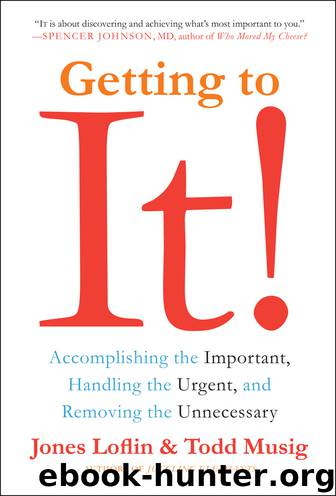Getting to It by Jones Loflin

Author:Jones Loflin
Language: eng
Format: epub
Publisher: HarperCollins
Published: 2013-08-07T16:00:00+00:00
Think about what you could do working on some element of IT for just fifteen to thirty minutes a day.
• Plan to focus on the ITs that require a lot of mental work at the beginning of the day, when you’re fresh and energetic. Your energy level and ability to focus on brain-straining ITs decrease as the day goes on. Plan for demanding mental labor early and physical tasks later when your muscles need a workout and your brain needs to recharge.
• Prioritize, prioritize, prioritize. The number of potential tasks you could choose to work on at any given moment is infinite. Prioritizing allows you to devote your brainpower to getting one thing done rather than endlessly bouncing from possibility to possibility.
• Do a double-check on your to-do list. Once you have your prioritized to-do list, correlate it with a list of the hours in the day. (You can use a purchased daily planner, the calendar in Outlook, or simply a sheet of paper.) Starting with your highest-priority task, block out when you are going to begin it and how long it will take. Continue down your task list, blocking out times for each task. Don’t be upset if you run out of hours in the day about halfway through your list—that’s okay, as long as you’ve genuinely made IT the top priority on your schedule. “Desirable but not crucial” tasks can be scheduled to tomorrow or another day. Forgive yourself for not accomplishing everything you wanted to do—you’re human, after all—but respect yourself for tending to the Important Thing.
• Employ the Four-D strategy. We’ve already discussed the Three D’s—delegate, delete, or delay—but it’s worth remembering one more D: do! More often than we admit, tasks that ought to take only a couple of minutes to complete end up taking much more time when they’ve been put off. In many cases, the most effective way of keeping a molehill from becoming a mountain is simply to finish it while it’s manageable. A good example might be that science fair project on electricity you promised to help your son with. If you had given him a few pointers weeks before the project was due, your son might have had just enough of a leg up to research it and confidently assemble it himself. But since you’ve told him, “Not tonight, tomorrow for sure,” right up until the day before his presentation is due, your sense of having let him down drives you to stay up half the night building most of his project for him and trying to teach him everything you know about electrical engineering.
• Create gaps and buffers of time. Be realistic about what you can accomplish in an hour or in a day. Allow time for the inevitable interruptions and crises. If your schedule is too full, the tendency is to drop the Important Things for the merely urgent ones. Research suggests that tasks typically take 20 percent more time than expected. So if you have a task you think will take an hour, add another twelve or fifteen minutes just in case.
Download
This site does not store any files on its server. We only index and link to content provided by other sites. Please contact the content providers to delete copyright contents if any and email us, we'll remove relevant links or contents immediately.
| Bookkeeping | Business Mathematics |
| Business Writing | Communications |
| Decision Making | Negotiating |
| Project Management | Running Meetings & Presentations |
| Secretarial Aids & Training | Time Management |
| Training |
Nudge - Improving Decisions about Health, Wealth, and Happiness by Thaler Sunstein(7659)
Deep Work by Cal Newport(6966)
Principles: Life and Work by Ray Dalio(6296)
The Doodle Revolution by Sunni Brown(4713)
Factfulness: Ten Reasons We're Wrong About the World – and Why Things Are Better Than You Think by Hans Rosling(4713)
Eat That Frog! by Brian Tracy(4483)
Thinking in Bets by Annie Duke(4185)
Hyperfocus by Chris Bailey(4086)
Visual Intelligence by Amy E. Herman(3753)
Writing Your Dissertation in Fifteen Minutes a Day by Joan Bolker(3696)
Ogilvy on Advertising by David Ogilvy(3554)
Hidden Persuasion: 33 psychological influence techniques in advertising by Marc Andrews & Matthijs van Leeuwen & Rick van Baaren(3519)
How to Win Friends and Influence People in the Digital Age by Dale Carnegie & Associates(3518)
How to win friends and influence people by Dale Carnegie(3438)
The Pixar Touch by David A. Price(3389)
Schaum's Quick Guide to Writing Great Short Stories by Margaret Lucke(3347)
Deep Work: Rules for Focused Success in a Distracted World by Cal Newport(3183)
Work Clean by Dan Charnas(3080)
The Slow Fix: Solve Problems, Work Smarter, and Live Better In a World Addicted to Speed by Carl Honore(2976)
